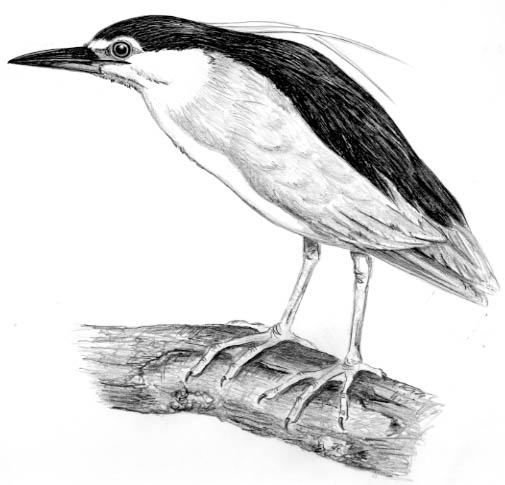
Dear Bird Folks,
Could you please help me identify the bird in the attached photo. It was taken near a Denver reservoir. As you can see it’s a fairly large bird, that’s mostly black and white, and looks like a long-legged penguin. It could be a heron, but the only heron that is listed for our area is the Great Blue Heron, which this is not. Any guesses?
– Angie, Highlands Ranch, CO
Ya know Angie,
This really isn’t fair to the millions of readers out there who can’t see your photo. I’m sure they would like to play guess-the-bird too. So, before I identify your bird I’m going to describe it for the people who may want to play along at home. Boy, this is going to be fun. Everybody ready? Here we go. The bird in Angie’s photo is bigger than a bread box, but doesn’t smell as good as one. That’s because this bird likes to stand in water, eat lots of fish and has breath that’s worse than a cat’s. It has a stocky body, stands two feet high, and has bright red eyes. Like Angie said, the bird has a black back and black cap on its head, while the rest of the body is solid white and solid gray. One final hint. The bird is common throughout much of the United States, but few people see them. Any guesses?
Let’s consider the last clue first, not because it’s the most important, but I’m afraid if I wait I’ll forget why I added it. How could a stocky, two foot high bird, with bright red eyes be common and yet most people never see it? It’s because the bird is most active after dark. An owl? Owls come out after dark. However, North American owls aren’t big fish eaters, except for the elusive flounder-eating-owl. But since I just made that bird up, it’s probably not one of those either.
Tall, stocky, fish-eating, plus black and white coloring does make it sound like a penguin. But a penguin in Colorado would be silly since penguins aren’t fond of mountain living. Since your black and white bird is not a penguin, that leaves us with two likely choices. What you saw, Angie, was either a Black-crowned Night-Heron or a nun on vacation. Right now I’m leaning toward the heron theory. Did anybody guess it? Come on, be honest.
Black-crowned Night-Herons are indeed one of the world’s most widespread herons. They are found on every continent, except Australia, Antarctica, and Atlantis. If you have significant wetlands in your area, chances are you’ll also have some of these handsome herons. Like most herons, black-crowns earn their living by wading in shallow water in search of fish. The trouble is the much larger Great Blue Heron also likes to fish in the same waters. To avoid conflict and the big heron’s nasty pointed beak, the black-crown schedules its fishing trips in the evening when it’s less likely to meet a great blue.
When roosting or breeding, black-crowns like each other’s company. It is not unusual to find roosts and rookeries of a dozen or more of these birds. Feeding, on the other hand, is a different story. Even in the dark they get upset when a fellow black-crown gets too close. They may be afraid of a great blue but they won’t back down from each other. With its bill snapping, each bird will protect its favorite fishing spot from any other black-crown that dares to encroach.
The best time to see these herons is at sunset. An evening walk along any marsh or wetland, within their range, could produce several sightings of black-crowns as they wing their way across the darkening sky to their feeding grounds. For years they roosted on the edge of a secluded pond near my house. Just as it got dark I’d see them fly over on their way to the local marsh. Recently the herons’ secluded roost has been replaced with houses. I don’t see them fly over any more.
In Colorado, Black-crowned Night-Herons leave after the breeding season for warmer parts of the world. Here on Cape Cod, many black-crowns spend the summer and a few even try to survive our winter. On cold, sunny, winter days they can be seen sleeping on exposed branches taking in the warmth of the sun. Most other birds sleep with their heads turned backwards, bills tucked into their back feathers. A black-crown on the other hand sleeps with its head tilted forward looking like someone’s grandfather nodding off after a Thanksgiving dinner.
Nice photo Angie. I could almost see the heron’s bright red eyes. During the breeding season the birds may be seen fishing at any hour. Finding enough food to feed the kids keeps the adults working day and night. That is probably why you were able to snap such a nice photo and that’s probably why the parent birds have such red eyes.